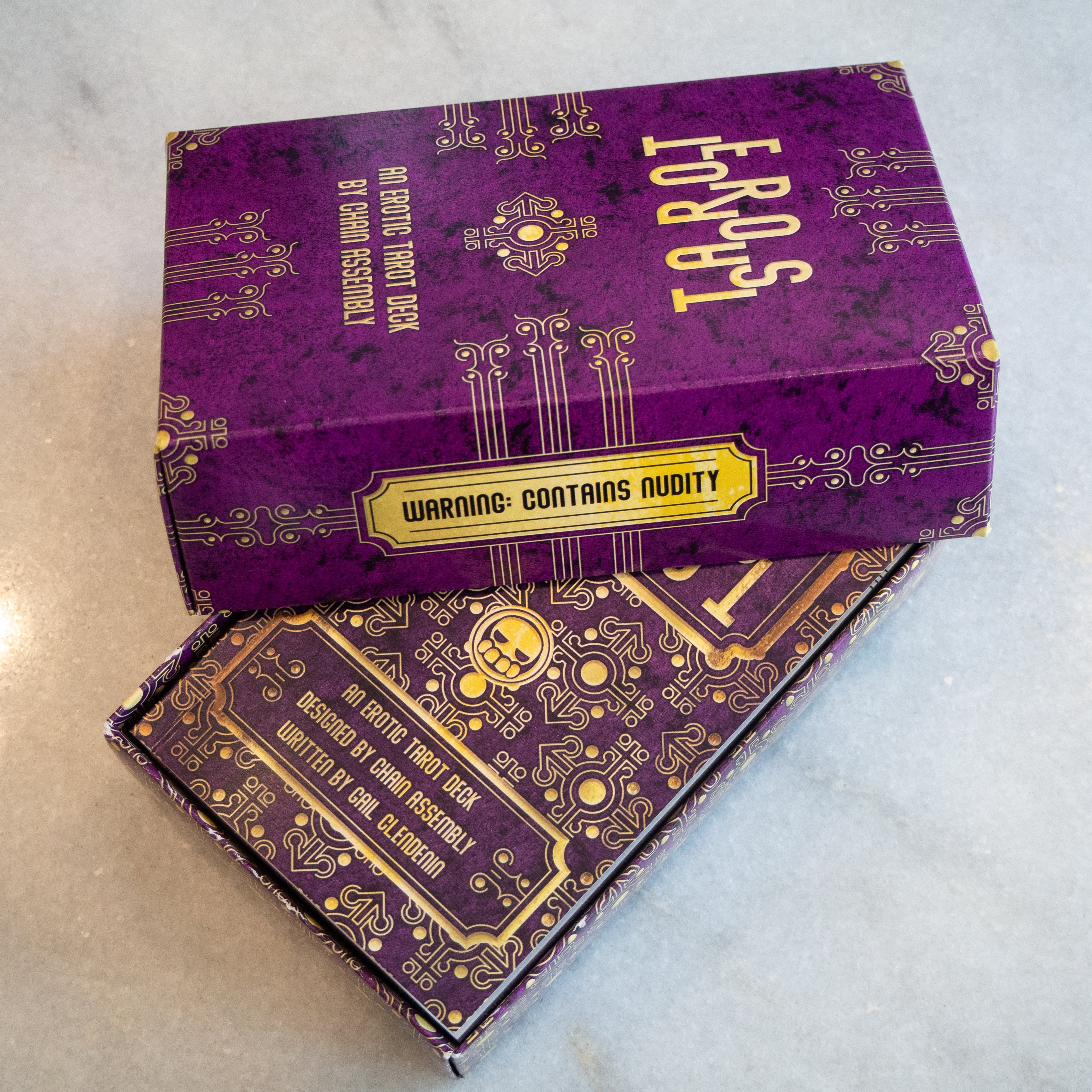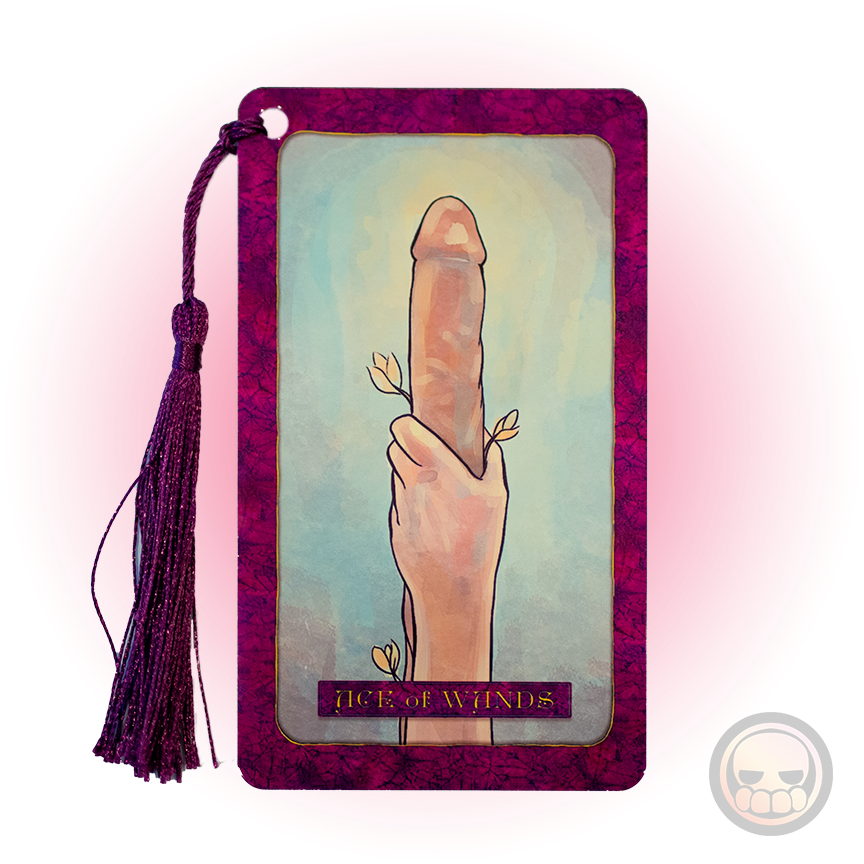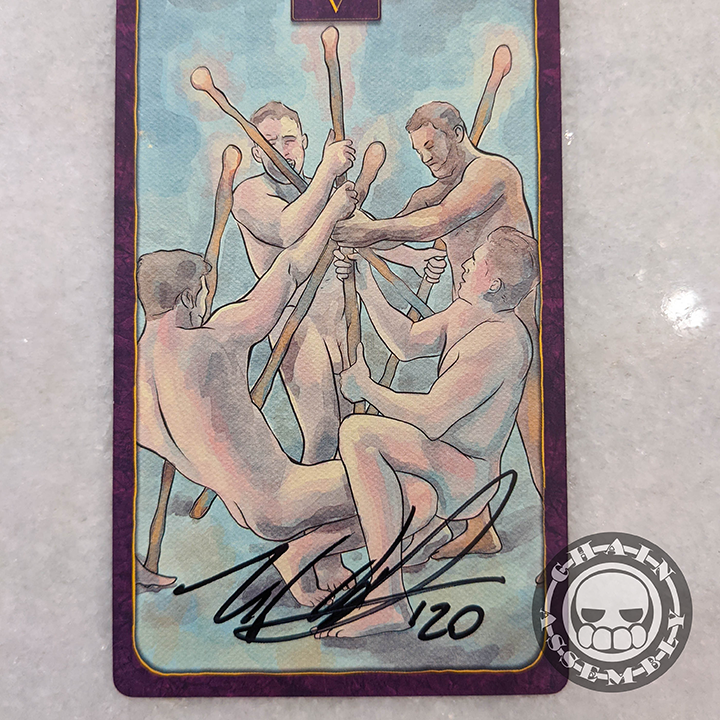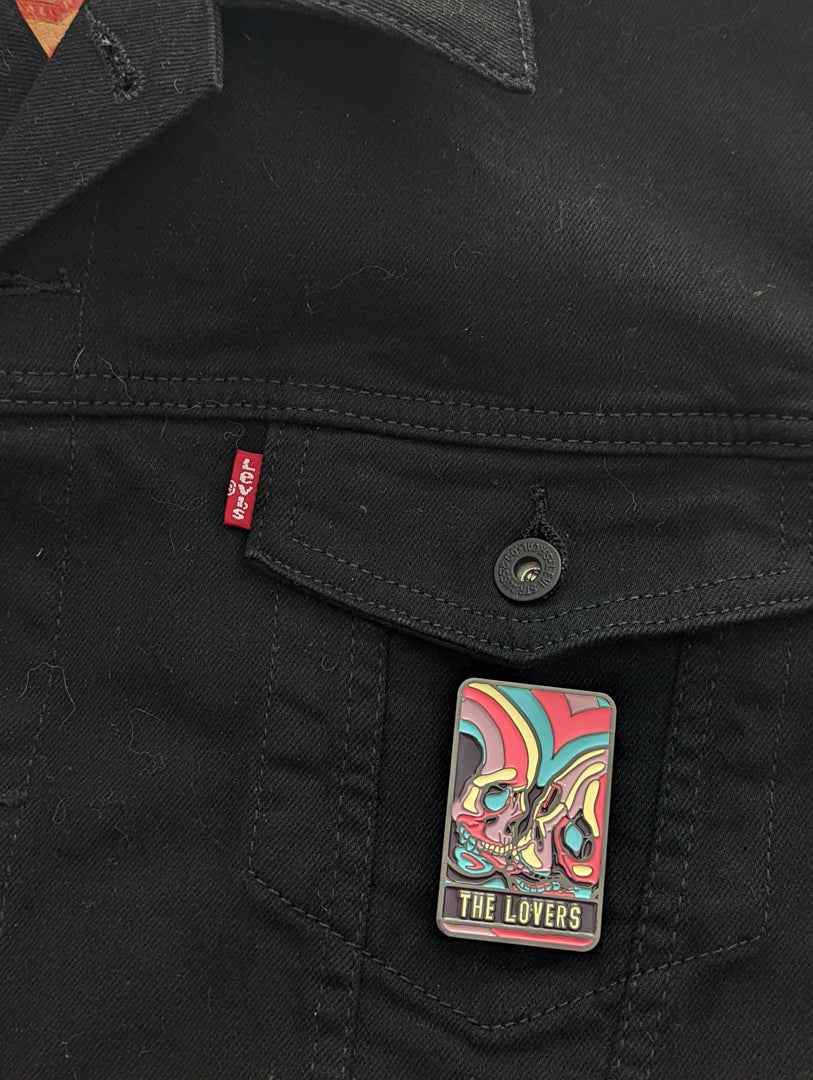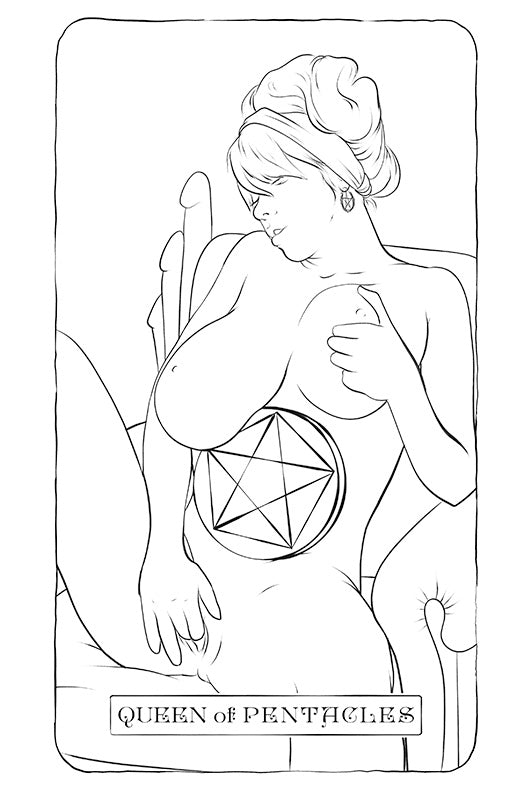

Eros Tarot: Second Edition
Illustration and design by Nick Ribera; Writing by Gail Clendenin
The first printing of Eros Tarot came out in early 2021. It was a pandemic project that explored sexual interpretations of the original Rider-Waite tarot deck. It touched hearts more than I could have imagined, and its reception meant a lot to me as an artist.
Between the first and this second printing, I learned a lot more about graphic design, writing, and the power of a tarot deck, so I wanted to make sure this new version was more impactful than the first.
Since its original release, I’ve made an oracle deck, a board game, and developed a subscription service for role-playing games. All of this is thanks to the original backers who supported my vision for a niche deck that wouldn’t survive the typical publication system.
"These cards are as emotionally complex as they are to witness"
Major Arcana
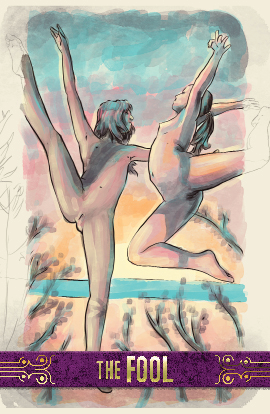
A journey begins with the fool. The fool is the innocent, the true novice, open to experience and brimming with potential. They hold nothing back and are prepared to leap in any direction, even into trouble.

The magician shows action and resourcefulness. With a traditionally-masculine energy, the magician represents the creative force of the ego. They exercise power and agency, but not necessarily with the wisdom of experience.

The high priestess represents inner knowledge and intuitiveness. With a traditionally-feminine energy, the high priestess sits strong between two pillars, between extremes. They have power and instinct, but not necessarily the wisdom of experience.
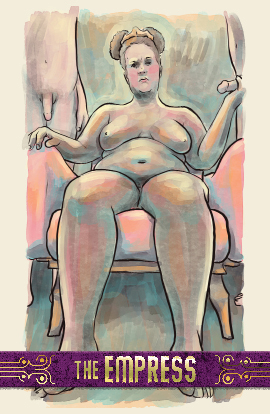
The empress epitomizes traditional feminine energy and the mother archetype. She has passion, creativity, and intuition. She is sexually satisfied and self-indulgent. Her approach to life is through feelings, pleasure, and care.

The emperor epitomizes traditional masculine energy and the father archetype. He has stability, decisiveness and authority. He carries out tradition and creates and defends boundaries. His approach to life is through the logical and methodical.

Tradition and structure are held in the hierophant: both the beauty of ritual and the conformity of maintaining social or cultural practices. The Hierophant can represent an inner sense of obedience, surrendering control or responsibility, or even spiritual growth.

The lovers show that passion can bring us briefly closer to the spiritual. The lovers represent important relationships, the experience of love, and deep connection.

The chariot shows a figure controlling a situation through willpower and personality. The sexual is controlled. Victory is achieved, but the situation is not reconciled. The chariot shows the ability you have to change the world around you.

Those experiencing the strength card find the ability to begin or continue difficult tasks. Strength is optimistic, eager. Strength provides a contrast to the chariot: facing situations with hope and internal strength.

The hermit finds a retreat to contemplate alone. Study, new knowledge, and focus on personal needs are the goals of the hermit. The hermit may represent a teacher or guide, someone focused not on outer concerns but deliberate self improvement.

The wheel of fortune shows us the power and forces that are beyond our control. It is an aspect of fate, a change in circumstances. The wheel demands that we figure out how to meet these changes: with acceptance, growth, or struggle.

The scales of justice are balanced, prepared to evaluate the past and future. Justice's eyes are uncovered, not blindfolded, and able to see the truth. But justice's eyes are closed, willing to seek wisdom and insight rather than judge the face of things.

The hanged man accepts their position and discomfort with a sense of calm. They understand that they are only in this situation for a time and wish to learn and gain what they can from the experience.

Death represents change: the end and beginning of things. Death is universal to life. Death precipitates rebirth and new life. We all experience change and must learn to accept it rather than fear it.

Temperance shows a grounded ability to adapt well to life’s circumstances. The qualities of temperance are balance, mixing elements, and choosing right action. It is peaceful but purposeful work towards a balanced life.
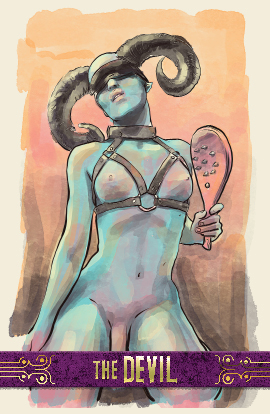
The Devil symbolizes the sexual as spiritual: physical and material experience that connects to something more profound. The devil shows us bondage, being trapped in service to the material or physical. It's meanings include being in servitude to something, indulging the darker side of yourself, and the feeling (not reality) of having no alternatives.

The tower is a card of sudden change. The tower will come apart, the feelings between the figures have already changed. Its meanings include the sudden change of an established situation, the end of a relationship, a time of upheaval, and a flash of insight.
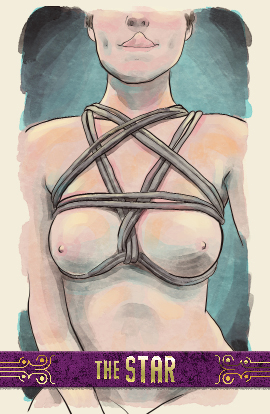
The star is a card of peace and healing after the storm of the tower card. The star echoes the calm and balance of temperance while giving a hint of the happiness of the sun. Find respite, rejuvenation, and regain your footing under the star.

The moon shows the dark and strange side of life. It represents a time of transformation and traveling through the unknown. The moon carries strong symbolism of the psychic, inviting us to look inward to our intuition. Finally, the moon carries strong traditionally feminine energy and power, further emphasizing intuition and emotional depth.

The sun is the embodiment of joy in the tarot. It represents happiness and experiencing a sense of beauty in life. The sun reminds us that we are a part of the entire world. We should notice, celebrate and soak it in.

Judgement calls us to live a meaningful existence. It is more than the evaluation of the justice card - it’s a call to look beyond the material world to the spiritual. It is the call to rise above our current selves, to answer a call from within or from beyond to something more.

The world is the completion of the fool's journey. The world shows us that the beginning and the end of things are all part of a single energetic whole. We are part of the universe and the universe is in us. The world embodies the wisdom of understanding and the unity of all of the elements in the tarot. It represents achievement, freedom, and the unification of the inner being and outer material being.
Suit of Cups

Cups are the suit of water, emotion, love, and creativity. Cups represent the inner being and what we are despite all that changes around us. Cups are a passive, rather than an active suit, as we pause to observe and reflect on our inner experiences.
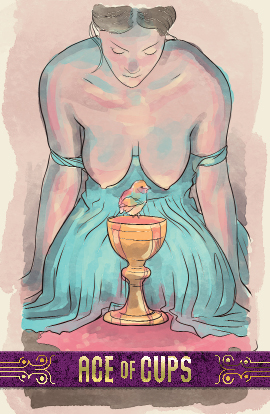
Inspiration, gifted or divine, in the suit of Cups. The Ace shows the deep wells of emotion and intuition available to the seeker. The waters of this overflowing cup take in experiences, friendships and romantic relationships, and gift insight and patience.
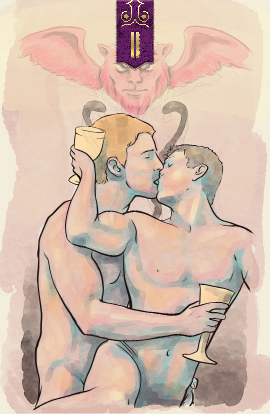
The union of the energy of two people. The two of cups shows the pleasure and harmony of mutual trust.

The three of cups is a celebration of the passion of this water sign. An emphatic, even divine experience of the way that emotion wells up and out of us in ways we feel must be shared.

The four of cups shows overindulgence, reaching beyond what we can stomach of our own emotions or the emotions and passion of others. What is the source of these overwhelming experiences and how can we find balance?

Emotional turmoil arises in the five of cups as we look to what is lost, rather than what is retained. Both situations are true, but where is our focus?

Each figure in the image holds power: one freely gives power to the other who uses it to direct the immediate situation. It is the quality of their communication and trust that determines the enjoyment each will have.

A wealth of physical and material pleasures are before us in the seven of cups. Which will we choose? Would any of these options provide meaning or depth of feeling beyond the moment?

We are in motion, up and beyond what we have built and accumulated. Stepping away from those accomplishments holds something new and enlightened. We are open to both risk and reward.

Look at all we have accomplished and conquered. What we seek is nearly complete and that effort is worth celebrating.

How satisfying to feel complete, whole, full in our emotions. What we have is satisfying and filling. We revel in what we have.

The page of cups is ready to explore the depth of emotion and intuition. They stand confidently, cup full of the wine of experiences yet to taste. The leaping fish often represents imagination, the wonder with which they explore their passions.

The knight of cups is at rest, using the intuition they have learned and gathering their understanding of their situation. This knight is patient and waits to act after understanding their options.

The queen of cups has mastered her intuition and uses it with grace. Always in touch with the flow of emotion around her, she is deeply creative in approaching decisions.

The king of cups wears his power with ease, working calmly within the waves and flow of the situations he must master. His relaxed, patient approach radiates calm to those around him.
Suit of Pentacles

Pentacles are the suit of earth. Pentacles are grounded, calm, a suit of work and patient progress. Pentacles represent the creativity of work, nature, growth, and material existence. But more than the mundane, pentacles show us connection with ourselves, our needs, and the earth around us.

Inspiration, gifted or divine, in the suit of Pentacles. The Ace shows the deep satisfaction that comes from steady progress, work, and nature. This gift of stability and groundedness can reassure the seeker of their path.

The two of pentacles brings us back to the simple but profound pleasure of connection with another person. The purely physical and sensational.

The three of pentacles echoes the ace of pentacles. In a community, the joys of pentacles' natural and physical qualities can be fully realized.

The four of pentacles is demanding, even selfish, but a bit precarious in its position. They holds their possessions tightly, but do they possess much or little?

The figure in the five of pentacles has found a place to rest, but is it within the space of the lit building behind or outside of its protection? They reflect on their circumstances and what they will do next.

The six of pentacles shows dynamic of power with echoes of the Devil. But where the devil has great power and control over those he has subjected, these participants are free to change their circumstances at any moment. They willingly, or even joyfully, participate.

The seven of pentacles shows the rewards of hard work paying off. But the work is not yet complete. Draw strength from what you have accomplished.

The eight of pentacles shows the task to be done and the tools of skillful work. The figure is focused on what they are creating, with an eye for the details.
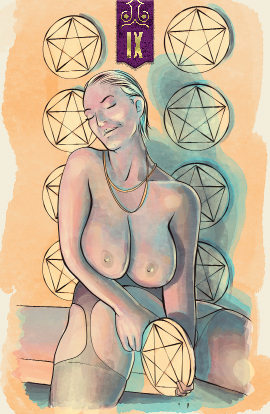
The nine of pentacles is a celebration of accomplishment, of work well done. Perhaps there is more to do and gain, but the rewards are worthy of enjoying.

The sense of completeness fills the ten of pentacles. Completeness of self, of work, of nature. What have you gathered? What do you possess that makes you feel whole?
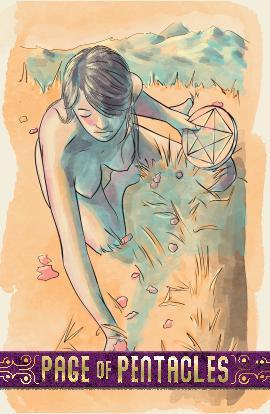
The page of pentacles is curious about the natural world around them and all it holds. They gather skills, experiences, and build the stamina needed to become what they envision.

Surrounded by lands to travel, the knight of pentacles stays focused on what they must accomplish. What skills does the knight have and what must they still master to succeed at their goal?

The queen of pentacles is the master of physical pleasures. She has great skill and takes pleasure in what she accomplishes.
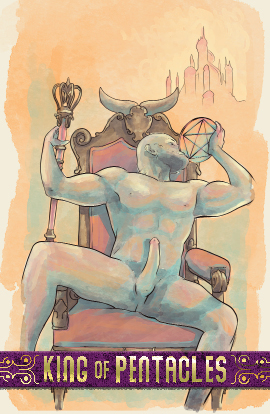
The king of pentacles possesses many types of wealth. He is sated, confident, and has much to share with those around him. His bull-like qualities make him stubborn.
Suit of Swords

Swords are the suit of air, spirit, and intellect. Air and the mind are in constant motion, never at rest. Sharp swords show the risks and impact of conflict. The suit of swords is an active suit, showing the exercise of emotions including fear, loss, and passion.

Inspiration, gifted or divine, in the suit of swords. The Ace shows the sharp spark of spirit and wisdom available to the seeker. This clarity can part through emotional turmoil, gifting new vision on conflict or difficulty.
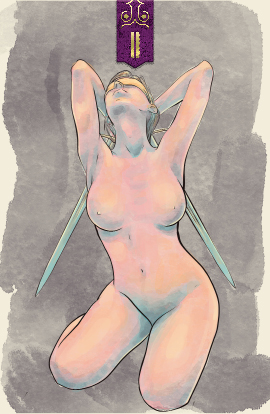
The two of swords shows a figure echoing justice, with eyes blindfolded and swords held tensed and ready for action. They hold the balance for a moment but would strike at any danger or uncertainty.

The three of swords shows the deeply painful side of swords as they have pierced the heart. This card represents a harmed relationship, sorrow, and loss--deep emotions that must be accepted and worked through in order to emerge on the other side.
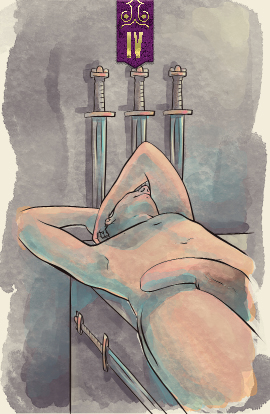
The four of swords represents withdrawal from the world, a moment of rest. The figure does not appear to be resting peacefully, but has withdrawn to put down their swords, to get away from conflict.

The five of swords shows an emphatic defeat. The figure on top has disarmed their opponent and sits in a position of power, sword still in hand. The figure on bottom has lost all they held. But which figure do you identify with?

A journey through a literally or spiritually difficult time is shown on the six of swords. The figure being ferried sits calmly and determinedly as they travel. The card represents going through a hard situation or through a transition without having to resort to conflict.

The figure in the seven of swords has taken action to handle their struggles, but must leave something behind. They look back, pleased at what they've accomplished but perhaps watching for pursuit. The card represents action taken against a problem that is not satisfying or does not solve the problem.

The eight of swords shows a person who is trapped. However, on second look, there are large spaces between the swords and their hands are not bound. They can escape their situation if they choose to. The blindfold keeps the figure unaware of their options.

The nine of swords shows a moment of great sorrow and anguish. The figure is not harassed by the swords suggesting that what troubles them may be happening to someone they care about. Love underlies the great pain that the figure experiences.

The ten of swords shows feelings of pain or suffering that outweigh the situation itself. The swords rest in the body bloodlessly and there are far more swords than needed to kill someone. The person experiencing the ten of swords may feel that their problem or situation is worse than it actually is.

The page of swords seeks the right direction for their strike. They observe what is in front of them, taking in the details, sword at rest on their shoulder. The page is learning and considering their environment before acting.

The knight of swords is the knight most in action. Caught in the moment of striking, they are filled with their emotions, having already made the decision to be in conflict. This knight is eager for battle, but will tire easily as they are still not as mature or experienced as the king or queen.

The queen of swords has faced the sorrow and conflict of the suit of swords and found wisdom from it. Now she sits in a posture of openness to experience, eyes bright and engaged with the world.

The king of swords knows when to choose conflict and when to choose other paths. He uses the mental focus of air to maintain laws and structure and uses his intellect as a tool for his kingdom and its people.
Suit of Wands

Wands are the suit of fire, striving, determination, and creation. Wands represent the energetic pursuit of making things, including the willingness to struggle. Wands are an active suit, always moving towards its interests, goals, or what delights it next.

Inspiration, gifted or divine, in the suit of Wands. The Ace shows the desire for movement, the joy of conflict and struggle, and optimism. This burst of energy can embolden the seeker to conquer challenges.

The figure in the two of wands has some accomplishments under their belt, but is now bored. They have lost direction and do not know what to do now that they have succeeded. The action and drive of wands leaves them restless.

The figure in the three of wands looks out at a possible journey, seeking their next course of action. They are eager but confident in their abilities and what they have already accomplished.
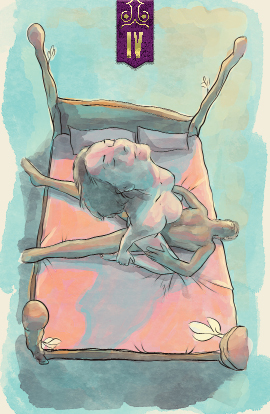
Two people celebrate together in the four of wands. The four-post bed they occupy is supportive but open, not restricting them in any way. This card can symbolize freedom and love of life.

The five of wands shows a competition, not to harm, but for pleasure. The players feel joy and comradery in their game. The card suggests the spirit of life as a battle that we join in eagerly.

The six of wands shows a moment of rest for the victorious. The figure has time to reflect on their accomplishments, represented by the wands surrounding them, and feels the satisfaction of their efforts.
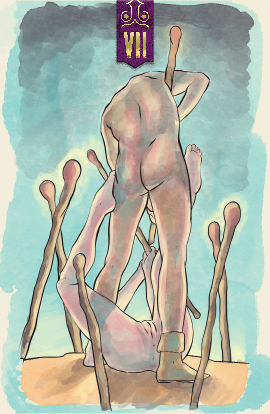
The seven of wands shows the excitement and satisfaction of conflict. The figure with the upper hand has faced many battles and has won them. The drive to action continues to propel them forward.
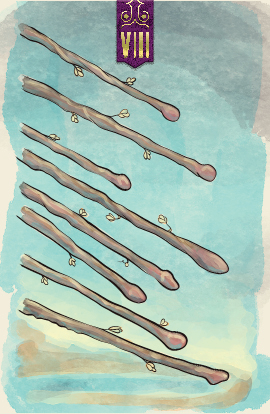
A card that represents movement in a suit that embodies action, the eight of wands shows wands striking rapidly toward their earthly target. The card suggests taking swift and focused action in a project or in love.

In the nine of wands, the figure pauses with fatigue as they have been in battle. They are weary and injured, but their conflict is almost at an end. The card suggests that we keep struggling toward our goal, but cautions that our vision may be compromised.

The figure in the ten of wands is burdened with all that they must carry. Because they constantly take on new projects and conflicts, they now have the heavy responsibility of everything they have committed themselves to. They need to find the other options available to them for managing their problems.

The page of wands is fire and action in a more youthful, beginning state. The page is enthusiastic to learn but may be more curious than lustful.

The knight of wands acts in pursuit of their pleasure, exercising control they have learned from experience wielding the fire element. But the knight is not all about control, they are about the excitement and the adventure of pursuit.

The queen of swords has faced the sorrow and conflict of the suit of swords and found wisdom from it. Now she sits in a posture of openness to experience, eyes bright and engaged with the world. The queen of wands loves life and enjoys it with confidence. She displays her sexuality with ease. The flower she carries represents the joyfulness and bounty of her experience.

The king of wands is a powerful, strong-minded ruler. He is a master of creativity. The king of wands is confident in his rightness and ability to know and pursue the truth, but he may do so with impatience in the process or in others who do not have his capabilities.




